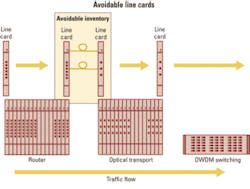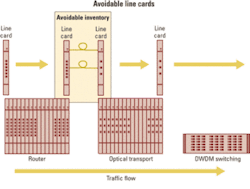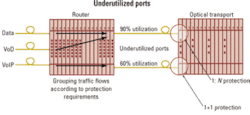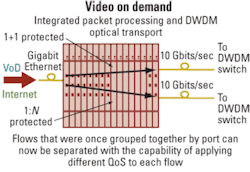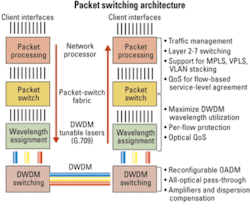Integrated architectures for packet-based traffic
As service providers continue to build-out metro and regional networks to support video, voice, and data services, their inventories of legacy and next generation equipment continue to grow. The challenge that providers are faced with is finding the right carrier grade network building blocks that are easy to manage and cost-efficient, with an emphasis on squeezing as much bandwidth as possible out of their networks.
The volume of data traffic has quickly surpassed that of voice traffic on metro networks. Because data is packet-based, metro networks have begun to transition to packet-based architectures instead of traditional TDM-based approaches. While service providers and equipment vendors are quick to jump on the Ethernet bandwagon, Ethernet specifications and interoperability among Ethernet equipment are still in their early stages.
The Metro Ethernet Forum (MEF) has responded to this need by uniting equipment vendors, service providers, and end customers in the definition of carrier grade Ethernet specifications. The MEF initiative has been widely embraced by many service providers and equipment vendors. Among these equipment vendors are some TDM-based vendors intrigued with the move to packet-based networking.
While legacy SONET equipment struggles to evolve in light of an ever-growing Ethernet and IP demand, current router equipment struggles with the demanding bandwidth requirements and carrier grade reliability expected by customers. Combining the strengths of these two very different architectures will require a system with the high-bandwidth capacity of a DWDM network, coupled with the traffic management capabilities of router networks. Can these technologies converge without breaking the budget?
Perhaps not surprisingly, most previous attempts to combine packet and optical switching failed because the solutions were overly complex and costly. Custom ASICs and size-prohibitive switching components made bringing these systems to market a time-consuming exercise, often causing a product to miss its marketing window of opportunity.
With the evolution of commercial silicon for high-speed packet switches and network processors, there are now numerous third-party components available that address both size and pricing concerns. Using these third-party components improves time-to-market, and pricing is attractive as competition between component vendors heats up.
Cost is often a driving factor in the decision to integrate packet switching and optical transport. Employing separate packet switching and optical switching equipment (see Figure 1) quickly exposes “avoidable inventory” that is needed to connect the two systems. In the simple case of connecting a router and an optical transport system, the aggregated traffic from the router must be handed off to the optical transport shelf for wavelength assignment and transmission. The line cards required on both systems add considerably to the total cost of the approach, with additional expense coming from costly optical components and framers.Another problem with a multiple-system approach is that aggregation logic must be restricted on each system, which limits the sharing of information between the systems. A router must package traffic flows, often according to protection schemes, to be handed off to the optical transport shelf (see Figure 2). Typically, they are common package sizes using OC-N or Gigabit Ethernet interfaces. Herein lies the first inefficiency: It may not be possible to fully utilize each of the output ports on the router. Underutilization quickly adds up, and the unused bandwidth on each port cannot be recovered once the traffic is handed off to the optical transport shelf. An integrated system would be able to adapt to varying traffic demands and provide per-flow protection without these packaging restrictions.Without packet processing capabilities on the optical transport shelf, intelligent data-aware grooming is only possible on the router. Once data has been handed offto the optical transport shelf, switching and routing decisions cannot be applied to individual flows.
Combining the packet-processing intelligence and optical-wavelength assignment into a single system solves the problem of avoidable inventory as well as the restrictions imposed by per-port protection. Figure 3 illustrates a port of client traffic carrying two types of content, each requiring different quality of service levels. An integrated system with packet processing capability allows these services to be separated, then protected differently. In this example, the service provider may wish to provide 1+1 protection to higher-revenue video on demand services while preserving resources with 1:N protection for Internet traffic that may not generate the same level of revenue. The end result is a system that makes better use of its resources.In many applications, carriers do not require the full functionality of a Layer 2 switch or Layer 3 router. Some examples might include the need to do Ethernet aggregation using virtual LAN switching or packet aggregation using MPLS switching. In these cases, the carrier does not need to buy a separate router and Ethernet switch. The integrated packet processing component of an integrated system functions as a multiservice switch/router at a fraction of the cost of a separate Layer 2 or 3 system.
Whether networks are TDM-based or packet-based, packet processing can be integrated with DWDM optical transport systems to cut costs and make better use of network resources. It is a relatively simple exercise that can no longer be discounted using cost or complexity as an excuse.David Psutka is director of product management at Intellambda Systems (Fremont, CA, www.intellambda.com).
